Uncategorized
ICYMI: Media coverage of our new SharedAirDFW air monitoring network
Downwinders Invited to Help DISD Write New Environmental Policies

Downwinders at Risk Director Jim Schermbeck is joining eight other area environmentalists in helping to produce an environmental and climate plan for the Dallas Independent School District.
Schermbeck was appointed by District 8 School Board Trustee Miguel Solis to the newly formed DISD Environmental and Sustainability Committee, which had its first (virtual) meeting two weeks ago. Molly Rooke from the Dallas Sierra Club, Mellan West from the North Texas Renewable Energy Group, former DISD teacher Bill Betzen, and Aaryaman Singhal from the local Dallas Sunrise Movement chapter are also members. Trustee Ben Mackey and DISD staff are leading the effort.
According to the resolution passed by the District back in February, the group is officially charged with the job of recommending “goals and progress measures, along with specific recommendations for acting on climate change that are within the purview of the District, such as: Curricular and Educational Opportunities; Facilities and Operational Priorities, including bond projects; Transportation and Food Services.”
Committee members will be meeting as a whole and in subcommittees from now until they make their final report by November 1st. Between now and then they’ll be community meetings to receive feedback in August and September.
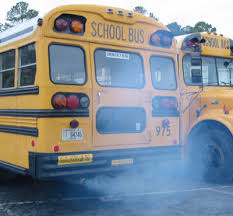
Since 2018, Downwinders has been pushing for full electrification of all DFW bus fleets a a way to address both the climate crisis and reduce PM pollution. Diesel and natural-gas powered buses are a significant source of PM exposure – from their tailpipes on the outside to the PM that migrates to their interiors. DISD owns the largest fleet of school buses in North Texas. None are electric and the school board just voted to buy hundreds of new diesel buses last year. So Schermbeck and the other electrification advocates have their work cut out for them.
Schermbeck will advocate for that agenda as well as other issues like less plastics use and landscaping to mitigate air pollution. He’s also hopeful the group can address how to extend their recommendations out into the neighborhoods surrounding schools via a new proposal that’s part of larger school bond package up for approval by voters in November.
A brainchild of Solis, the effort ties a portion of facilities improvement monies to providing community needs at DISD school campuses in neighborhoods suffering the greatest lack of services and resources.
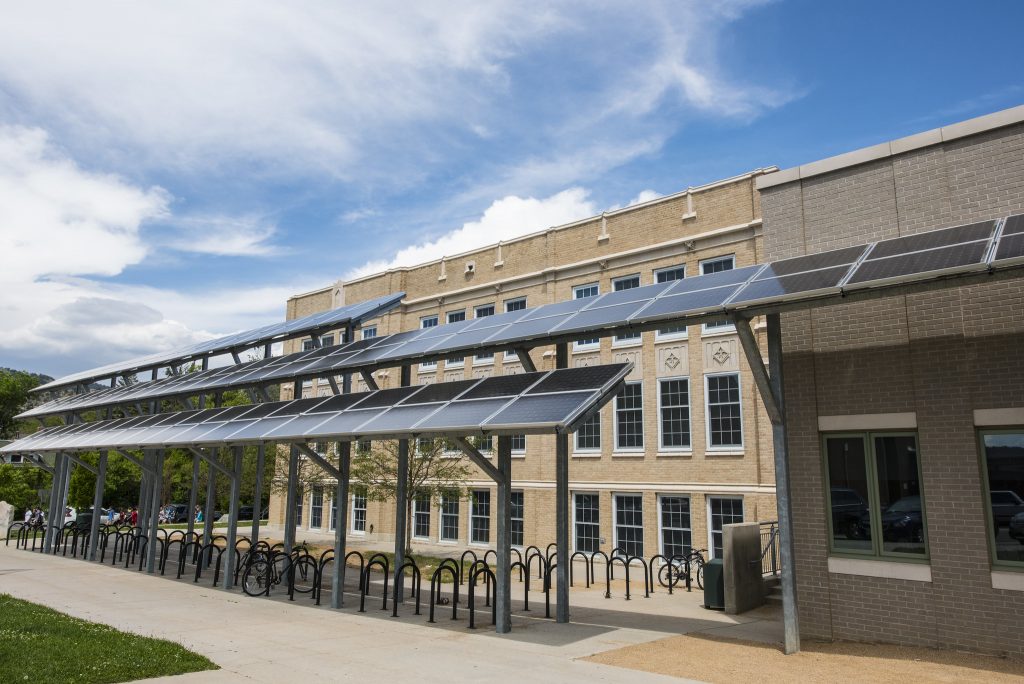
$40 to $50 million out of the bond’s whopping total of $2 billion is expected to be earmarked for this effort, distributed over just four school feeder routes at first: LG Pinkston High School in West Dallas; Franklin D. Roosevelt High School in Oak Cliff; Lincoln High School in South Dallas; and H. Grady Spruce High School in Pleasant Grove.
The idea is for the school district to extend itself into the community sending its students to its schools, and in doing so help fulfill an identified community need. For example, a school in the middle of a food dessert could help build a grocery store on school property. A school in an area that suffers from a high rate of childhood asthma could build a new family health clinic. Solar or electric bus battery electric power generated at a school site could be sold to surrounding residents at a reduced rate.
As far as anyone can determine, Dallas is the first school district in the nation to try something like this. Its creation is far from certain – the bond package is already encountering opposition because of its size – but the District’s willingness to be creative is admirable.
Even if the new bond goes down to defeat they’ll be a list of new environmental policy recommendations left by the Committee to implement in current facilities and operations. With any luck those will also be pushing the envelope. Stay tuned.
Citing Overt Racism, Marsha Jackson Sues Dallas over Shingle Mountain
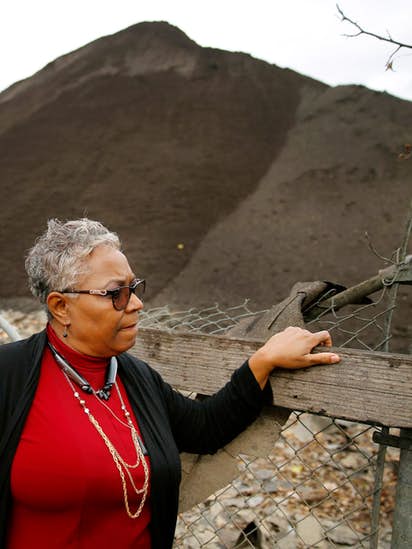
of ground-up shingles next door to her house assaulting her health.
Arguing that the City Of Dallas has always had the authority to clean-up the huge illegal Shingle Mountain dump in Southern Dallas, but chose not to because it’s in a predominantly Black and Brown neighborhood, lawyers for Marsha Jackson added City Hall as a defendant in their federal lawsuit.
Dallas joins the Rogue’s Gallery of grifters, including former operator/con man Chris Ganter and his accomplice landowner Cabe Chadick, being sued by Jackson’s lawyers, famed civil rights attorneys Mike Daniel and Laura Beshara.
At issue is the creation and continuing health threat caused by Dallas’ largest illegal dump – a 100-foot high, 100,000 ton pile of asphalt shingles that began surrounding Jackson’s house in Janury of 2018.
Speaking on behalf of Jackson’s in their amended complaint filed July 8th Daniel and Besharal state, “The City, along with the operator and owner, is responsible for the existence of Shingle Mountain.” The trail of official negligence they document backs that claim.
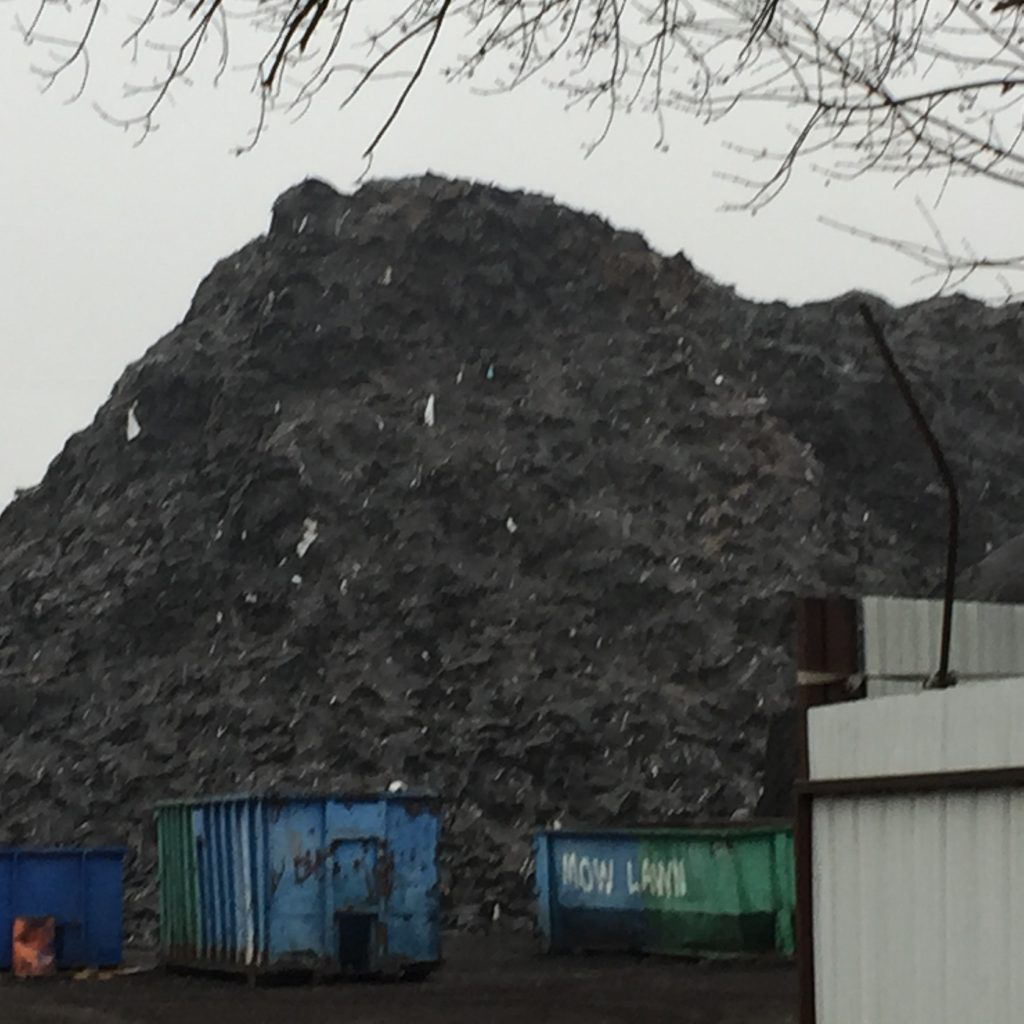
Shingle Mountain’s operators were in violation of numerous city regulations and laws the day it opened. They violated a specific deed restriction put in place to prevent the very dumping from which they profited. They didn’t have a required Special Use Permit. They didn’t have any solid waste or storm run-off permits. They had no pollution permits to spew asphalt dust into the air by the tons. And they had set up shop in a floodplain which made the entire business an illegal use. Incredibly, the City of Dallas issued the dump a Certificate of Occupancy anyway.
But the suit does more than document the specific abuses leading up to the creation of the Shingle Mountain crisis. It also cites a pattern of racist zoning the City knowingly put in place that practically rolled out the red carpet for the con men responsible for the dump.
The City Council deliberately changed the zoning on the Shingle Mountain dump site to the heaviest industrial zoning possible despite knowing that Ms. Jackson’s home and other homes were adjacent to the site. The City changed the zoning knowing that the heavy industrial zoning adjacent to the homes violated City zoning policies.
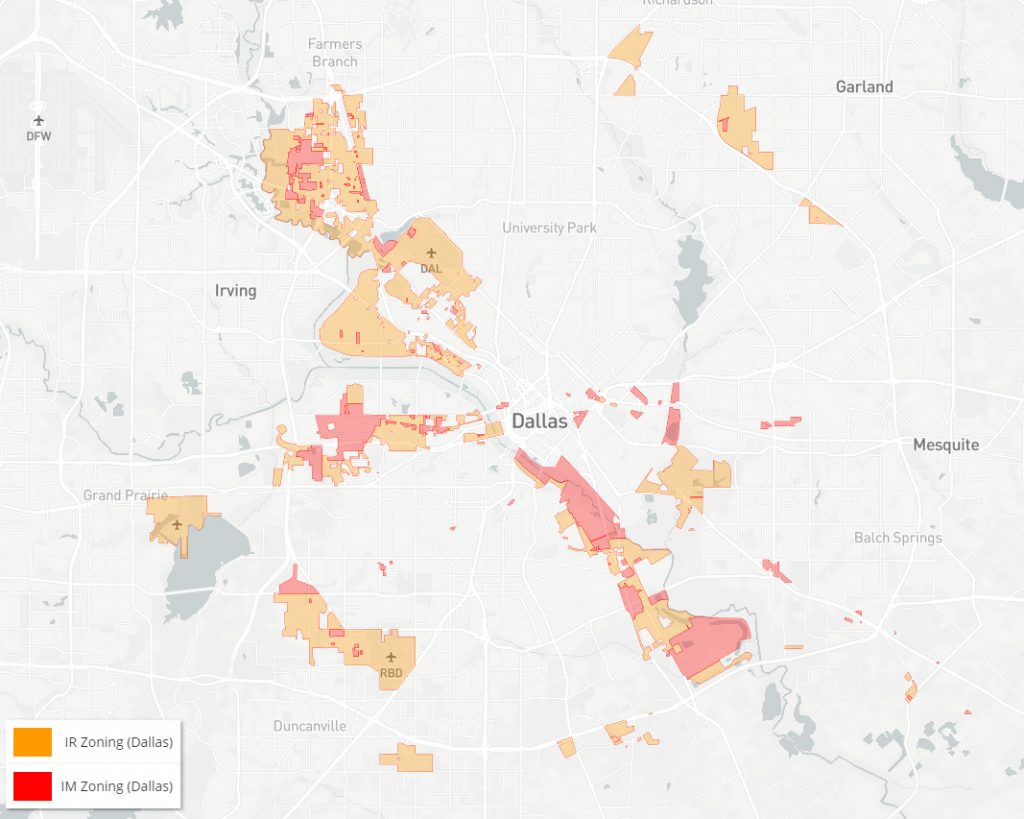
Jackson’s suit points out there are no industrial dumps in predominantly White residential neighborhoods in Dallas. The City Council hasn’t approved or contributed to the presence of illegal dumps in predominantly White residential single-family neighborhoods. The City hasn’t issued permits in violation of deed restrictions and doesn’t impose heavy industrial zoning adjacent to single family homes in predominantly White residential neighborhoods. There are no Shingle Mountains or any illegal dumps in a predominantly White residential neighborhoods in Dallas. With only one limited exception there’s no industrial zoning adjacent to ANY predominantly White neighborhoods in Dallas.
It also cites several example of when the City moved quickly to pay for contaminated sites…when developers requested it. In 2010 the Dallas City Council expended over $1 million in City funds to provide for the removal of lead soil contamination for the construction of Belo Garden park downtown. In 2015, the Dallas City Council paid $2.5 million in City funds to relocate and remove the Argos batch plant out of the newly gentrified “Trinity Groves” district and relocate it deeper into West Dallas where it’s adjacent to Black and Hispanic neighborhoods.
But in 2019, when Marsha Jackson requested funding for the clean-up of Shingle Mountain because of escalating health problems, the Dallas City Council refused.
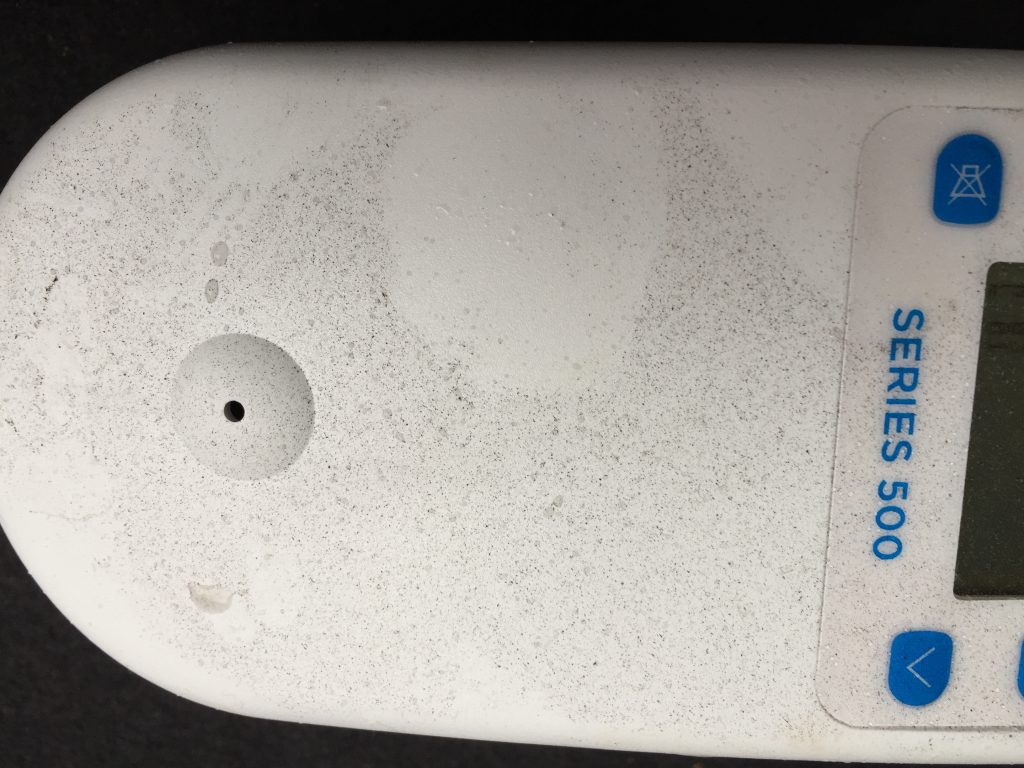
As a result , Jackson’s lawsuit against the City is for: 1) violation of the federal environmental laws by contributing to the creation of the illegal landfill and 2) for treating her differently on the basis of race by creating the industrial zoning that is harming her and by failing to remove the illegal landfill when the City acts to perform environmental remediation in white areas. Ms. Jackson’s suit against the City asks for the City to enter onto the Shingle Mountain property and remove the illegal landfill. She asks for the City to clean up the Shingle Mountain property to remove the environmental and health hazard and to re-zone the property to a compatible use for the homes that are next to the location.
Since the first day it opened for business without any warning, Ms. Jackson and her neighbors have complained about health problems, including respiratory and neurological problems. Specifically, they’ve cited poor air quality resulting from the black dust permeating the air they were breathing. Three years of decomposition is stripping carcinogens and toxins like Silica, Formaldehyde and fiberglass from their adhesive backings and putting them into the air as Particulate Matter pollution. In these summer months, standing downwind of the dump is like standing next to an asphalt batch plant or oil terminal, with fumes overwhelming even the most healthy.
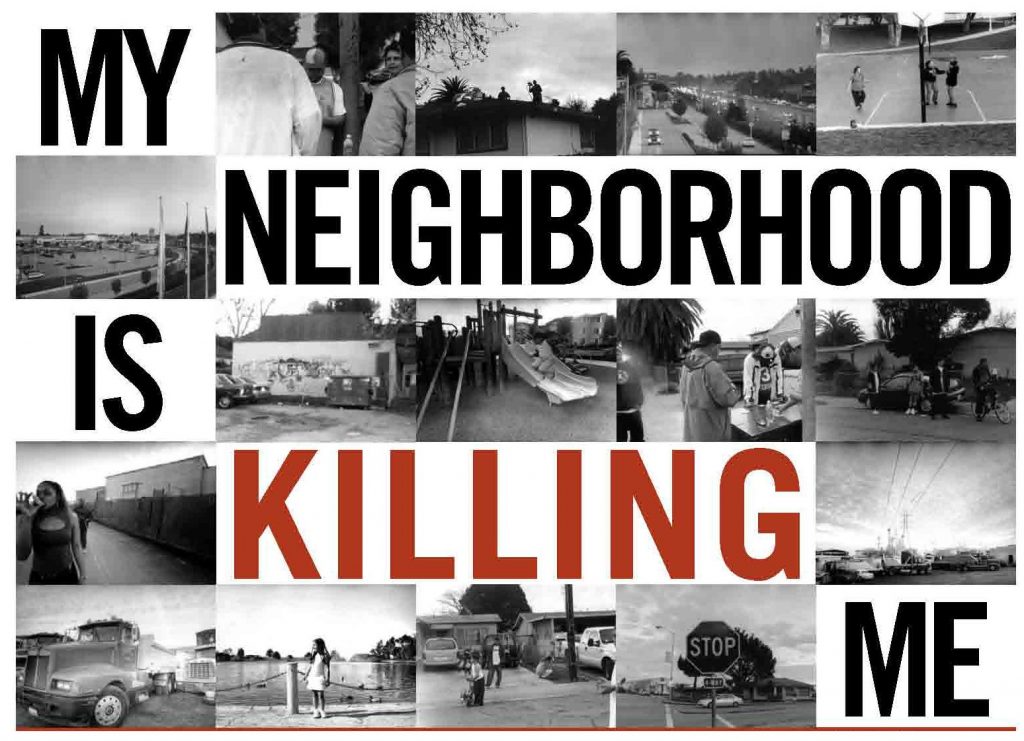
Perhaps most infuriating of all is the argument by Jackson’s lawyers that the City has had the authority to act to remove the dump at any point over the last almost-three years:
“The City of Dallas has the legal power to require the removal of Shingle Mountain. It can summarily abate the use because it is located within the floodplain. The use is not one allowed by the City in a flood plain. Texas law gives the City of Dallas the power to abate the violation by causing the work necessary to do so after notice and an opportunity to comply to the owner. If the owner, as in this case fails to comply, the City, without legal action, may pay for and cause the work to be done and assess the costs to the owner. Until the costs are paid,interests at 10 percent per year and the City has a lien on the property for the costs incurred and the interest. (Tx. Local Gov’t Code. § 54.020.)”
After three years Dallas has seemingly run out of excuses for its discriminatory treatment of Marsha Jackson and her neighbors. A well-worn truism is that the only time the City responds to its residents is when a lawsuit is at stake. Now that the City has been named a “responsible party” to the crisis in a lawsuit, Jackson’s plight might actually be a priority at City Hall.
Does Dallas have an Air Monitoring Policy? Yes, It’s called “CYA.”
In March the City of Dallas invited a speaker to its Climate Symposium to advise them about air pollution monitoring for environmental justice. By June, they’d already ignored him. Another great short by Rick Baraff.
TUESDAY TOWN HALL ON RACIST ZONING
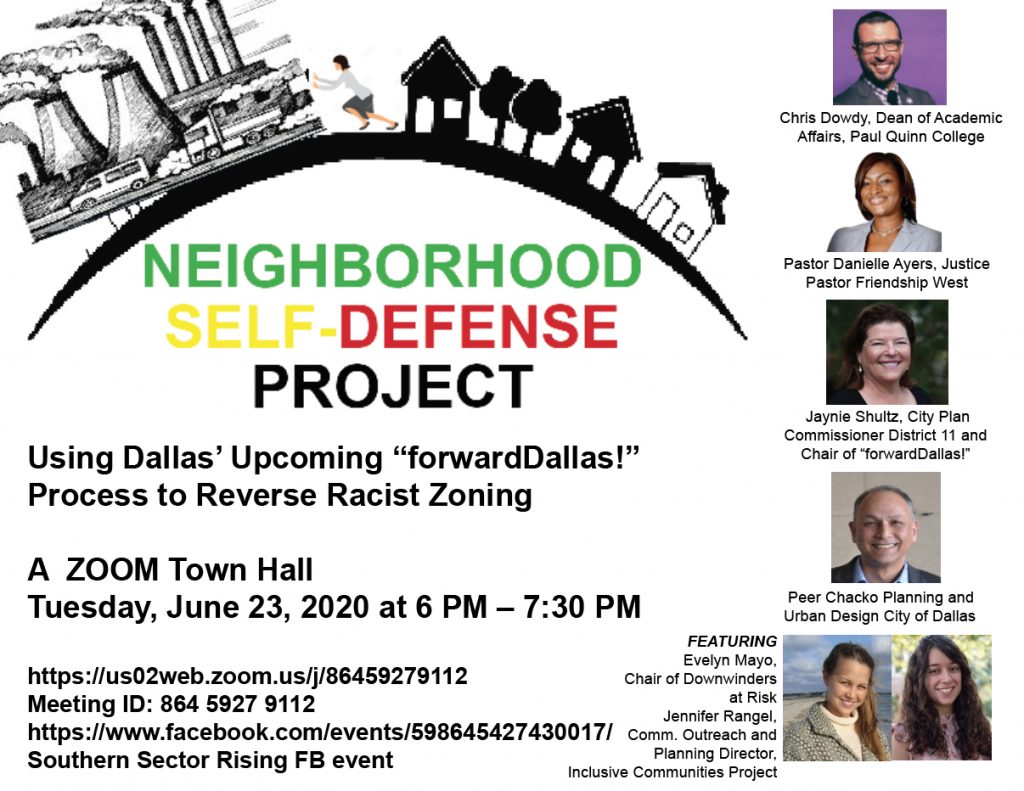
Join Us for Another Timely Town Hall on Environmental Justice This Coming Tuesday
Our Neighborhood Self-Defense Project is on a Mission to Eliminate the Racism That Redlining Left Behind.
It’s a funded, multi-year campaign to re-map pollution burdens in Southern Dallas. Learn about this exciting new challenge
to the Status Quo. We can make sure new
Shingle Mountains don’t happen.
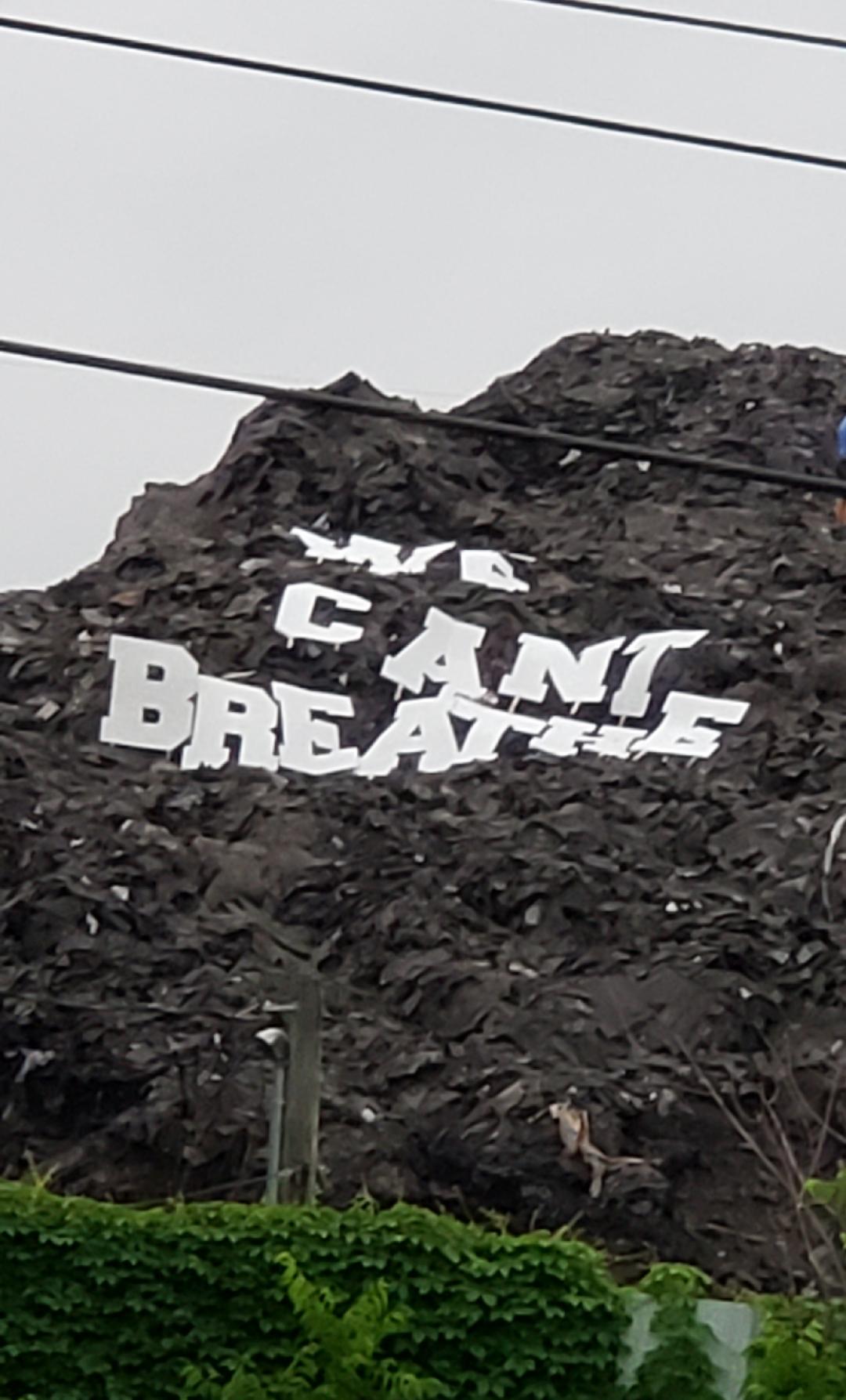
| Like you, we’re tired of playing defense. We want to start making fundamental changes to the status quo. An upcoming city-wide comprehensive re-examination of Dallas zoning gives us that opportunity. While overt racist tools like redlining and neighborhood covenants are gone, the patterns of land use they left behind still haunt South Dallas.  The reason most polluters are found along and South of the Trinity River in Dallas is because that was one of the very few places they, and Black and Brown residents, were allowed to locate. All were considered “undesirable” by the White Powers-That- Be. Redlining meant both people and industry were segregated. Paul Quinn’s recent report, “Poisoned by Zip Code,” explicitly maps this on-going industrial segregation. It’s the mundane but fundamental tools of city zoning and land use that have propped-up this obsolete legacy of racism for decades. It’s these same tools which must be used to reverse it, only this time wielded by the residents themselves. That’s the idea behind the Neighborhood Self Defense Project. Southern Sector Rising, The Inclusive Communities Project and Downwinders at Risk are combining to take on the task of organizing residents to remake their neighborhoods, tract-by-tract by taking advantage of the City’s upcoming “forwardDallas!” process.  Sponsored by Dallas City Hall once every decade or so, “forwardDallas“ is a comprehensive neighborhood planning process that can redraw the futures of communities to better reflect residents’ desires. Usually it’s another consultant-driven under-utilized City Hall exercise that gathers dust on a shelf. But a number of factors make this time different. For one thing, we and our allies are prepared and funded to wage a multi-year campaign to see the process all the way through. We’ve already begun holding organizing meetings with specific neighborhoods to get them ready. We’ll be there when the City holds its meetings. We’ll be there when the final document is written and when it passes the Council. This is the first time a grassroots campaign like this has been organized specifically to take on the “forwardDallas!” process on behalf of Southern Dallas residents.  Secondly, the Plan Commissioner who will be Chairing the City’s “forwardDallas” Committee is committed to packaging a lot of fundamental change into the final resolution. District 11 Commissioner Jaynie Schultz has been an advocate for Southern Dallas residents in past fights over batch plants. She wants residents to submit their own neighborhood plan for immediate adoption by the Council instead of waiting for up to three years to go through the usual hearing process. Third, the Dallas City Council just passed its Climate Plan which pitched the hot potato of environmental racism to the “forwardDallas!” process to address. Commissioner Schutz has said she wants to take this problem head on and the Council just gave her their blessing to do that. Finally, thanks to our supporters, we’ve made the on-going Shingle Mountain disaster a very real and living symbol of the impacts of this kind of racism. City officials know they have to do something. Our job is make sure that something is as big and deep and impactful as we can make it. Tuesday’s Town Hall is our official debut of the Project. It’ll offer a run through on how “forwardDallas!” works as well as how to get a head start for your own neighborhood plan. We’ll be joined by: Chris Dowdy, Dean of Academic Affairs at Paul Quinn College Rev. Danielle Ayers, Justice Pastor at Friendship West Baptist Church Jaynie Schultz, D11 Plan Commissioner and the Chair of the “forwardDallas!” Committee. Peer Chacko, Chief Planning Officer and Director, Planning and Urban Design Jennifer Rangel, Community Outreach and Planning Director with The Inclusive Communities Project Evelyn Mayo, Chair of Downwinders at Risk, author, “Poisoned by Zip Code”  Racist zoning is a “pre-existing condition” that keeps Southern Dallas residents trapped in disproportional poverty and illness. We have a unique chance to fundamentally improve public health and end one of the most harmful legacies of Jim Crow. |
LEARN HOW TO REVERSE RACIST ZONING
ENVIRONMENTAL JUSTICE
ZOOM TOWN HALL
THE NEIGHBORHOOD SELF-DEFENSE PROJECT
Tuesday, June 23rd
6 pm to 7:30 pm
https://us02web.zoom.us/j/86459279112
Meeting ID: 864 5927 9112
A FaceBook Live Event on Southern Sector Rising
Dallas City Hall Shows Concern Over Joppa Air Quality – By Putting New Air Monitor 3 Miles From Joppa
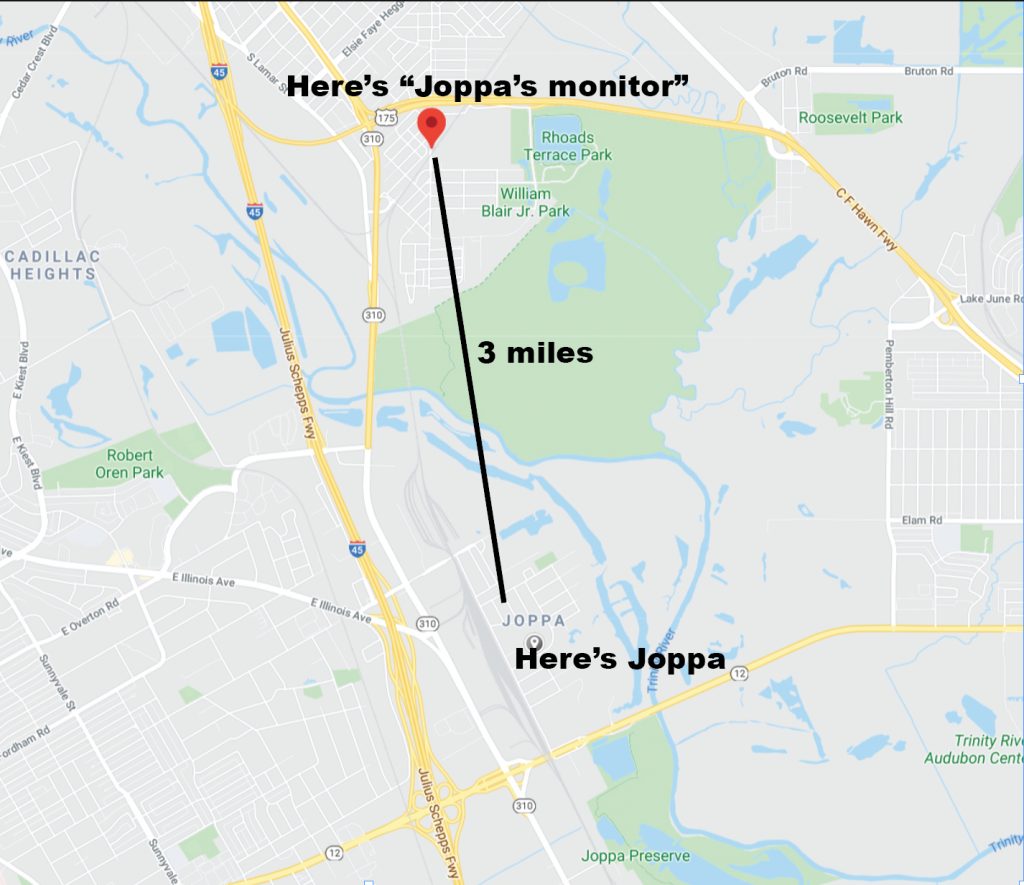
On May 27th Dallas City Hall rejected pleas from Southern Dallas residents and supporters to establish an Environmental Health Commission as part of its new Climate Plan.
On June 1st it provided the best reason yet as to why one is so desperately needed.
Proclaiming that the city had finally come through with a new air monitor for the beleaguered Joppa neighborhood, Office of Environmental Quality staff reported to the Council’s Environmental and Sustainability Committee that the new monitor the residents had fought so hard to get would actually be located…3 miles away on Bexar Street in Bonton.
3 miles away.
Staff rationalized putting “Joppa’s air monitor” (yes, they kept calling it that) in Bonton by promising it would reflect what Particulate Matter air pollution Joppa residents were breathing from the combination of batch plants, locomotives, and a large asphalt shingle factory…3 miles away. Committee Chairman Omar Narvaez went out of his way to make the same point. In fact, he patiently explained to the video audience that you could actually get more accurate readings for Joppa pollution from Bonton, 3 miles away, than you could in Joppa itself!
But not only is none of that true, it directly contradicts everything science knows about how Particulate Matter air pollution is transported and deposited. Donald Trump could not have done a better job of inverting the facts.
Smog is like a blanket. PM pollution is like sparklers. Smog rolls in large slow moving masses of air over many miles. PM is local and unless its coming from a 100 foot smokestack or fire, will not travel en masse 3 miles downwind undiluted. Smog is lighter than air and accumulates. PM is heavier than air and falls to the ground.
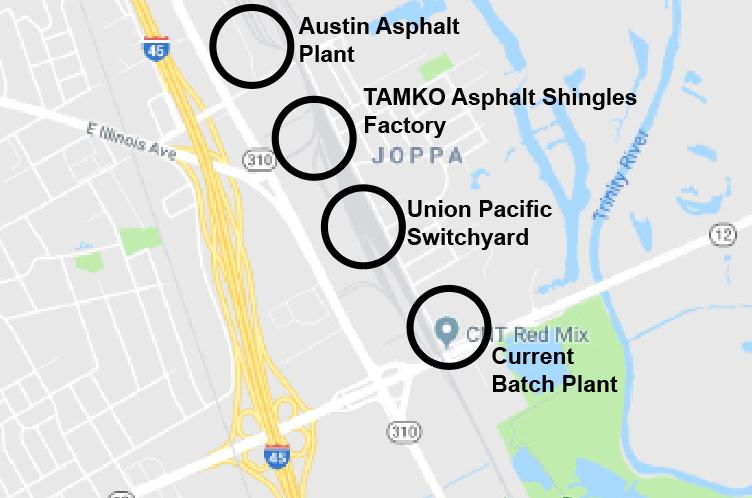
Smokestacks in Joppa are a lot shorter than 100 feet and their pollution is rarely as dense as house fires. PM pollution from these sources will not travel 3 miles downwind without a very heavy wind. It will travel 500 to 2000 feet. A monitor 3 miles away the Joppa pollution sources is incapable of telling you what people are breathing across the street from them. Heck, it’s incapable of even picking up the dust from the Bonton Farm goat herd 2000 feet down the road.
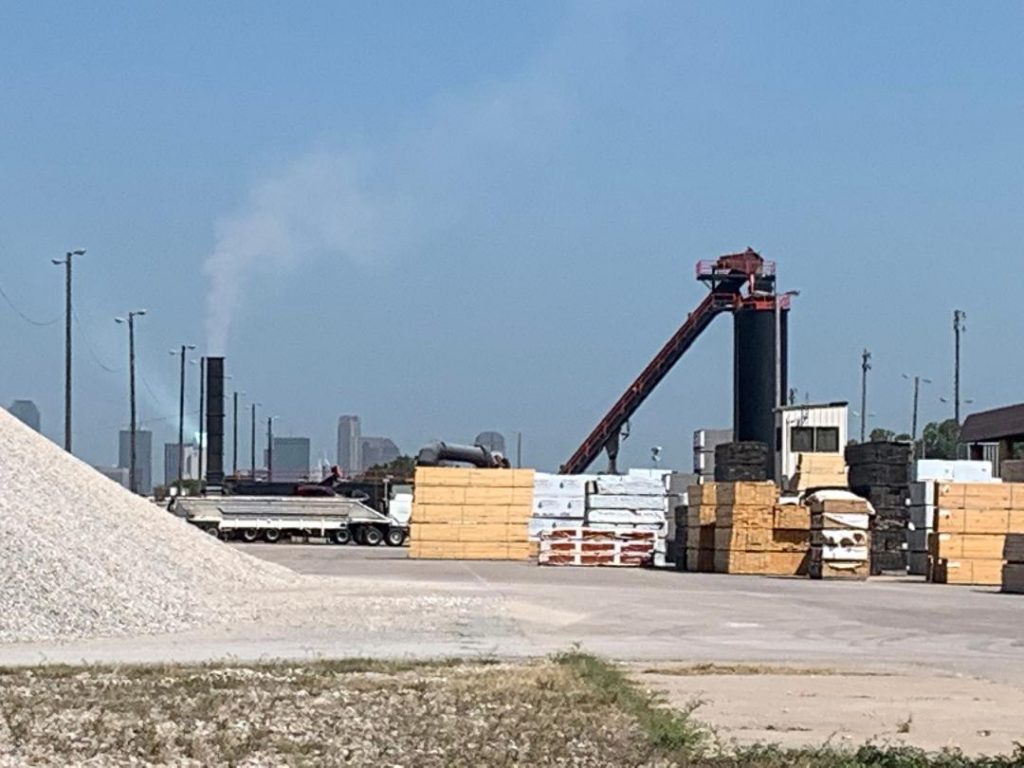
The localized nature of PM pollution – it could be very bad on one end of a street block and fine on the opposite end – is why experts like UTD’s Dr. David Lary are advising local governments to place PM monitors every mile or even half mile from each other in dense networks. Scientists such as Dr. Lary have devoted hours to research showing how PM monitors must be packed close together in order to reveal what people are actually breathing from location to location. A single monitor is incapable of accurately reflecting all the sources of PM pollution in a large area, much less telling you what different neighborhoods next to those sources are breathing.
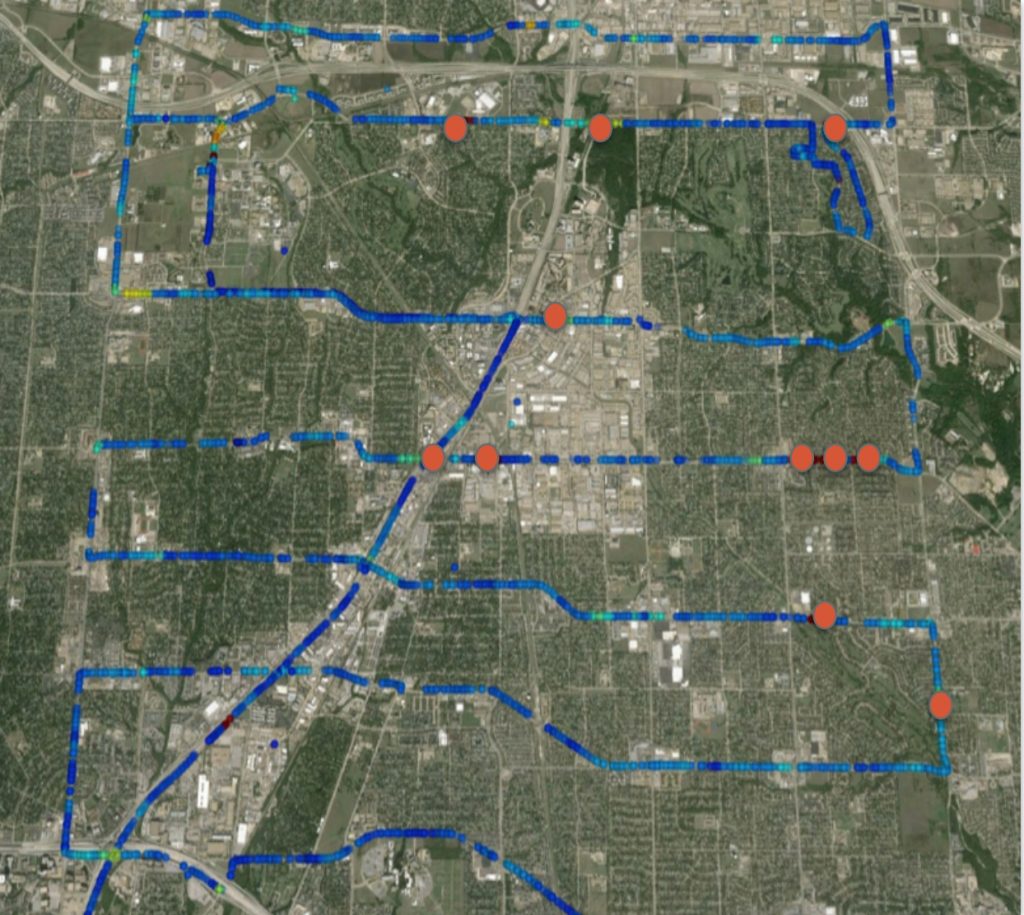
If a Council Member had asked the most preeminent expert on PM air monitoring in DFW, he could have told them all this. But Dr. Lary, who has worked for NASA, was not asked. Nor were any toxicologists, or professional air scientists of any kind.
Staff and Chairman Narvaez’ assertions about the uselessness of next-to-source fenceline monitoring to reveal air hazards will come to a shock to the countless industry and government entities employing it to understand more precisely where air pollution problems are generated. EPA even has guidance for such monitoring, saying “New cost-effective approaches to measuring air pollutants at the fenceline or in communities near industrial facilities can help identify and control air pollution that may drift across property lines.” We could find no EPA guidance recommending monitoring local PM sources from…3 miles away.
Somebody from EPA could have told the council about that that if they’d asked. But they didn’t ask a real air modeler or researcher from EPA, or anyone else that knows what they’re talking about when it comes to air pollution. As a result, council members are endorsing an anti-scientific, backasswards approach to air monitoring guaranteed to make real scientists roll their eyes and sigh. It’d be funny if it didn’t involve real people’s health and well-being.
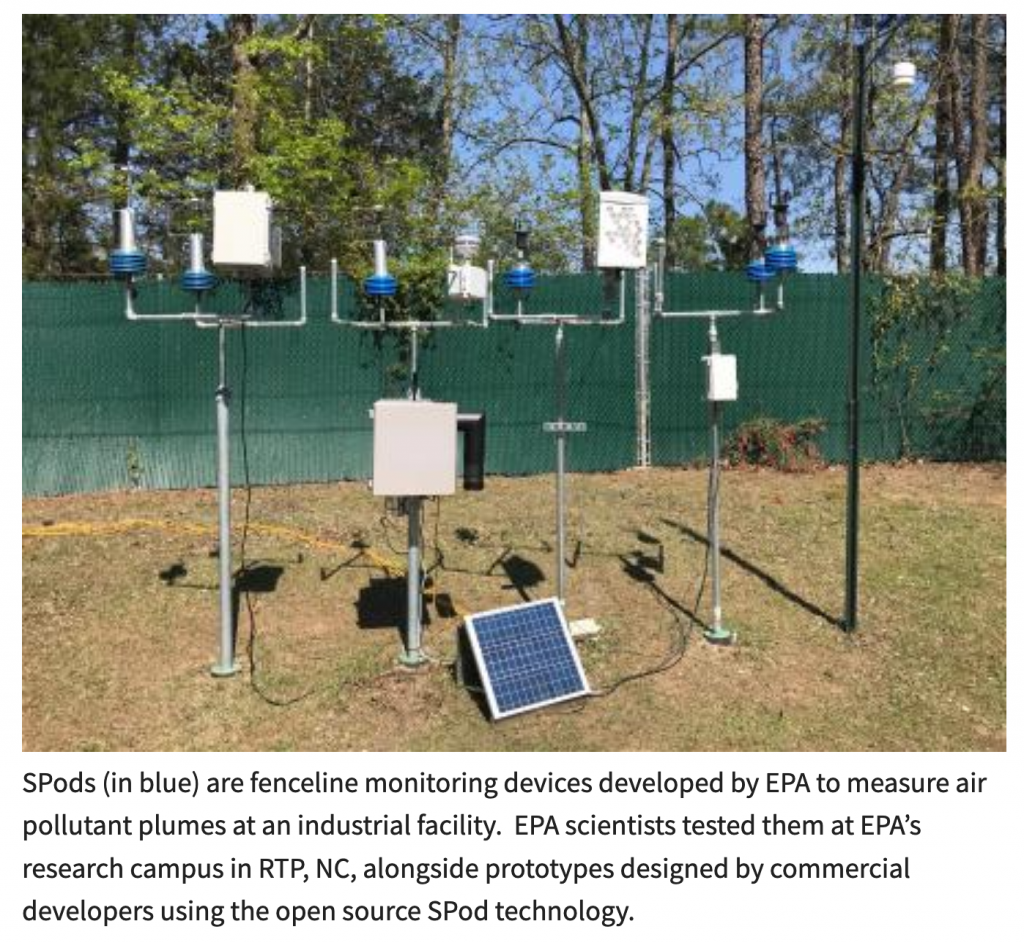
To know what the residents of Joppa are breathing, science says you must monitor the air in their community, not the air 3 miles away from their homes. By putting the monitor adjacent to the Joppa sources, you’re able to capture what pollution is really trespassing into residential neighborhoods and possibly causing problems. You might even be able to hold specific polluters accountable. By putting the monitor 3 miles away, you can’t do that. At that distance, there’s no way to tell what’s producing the PM levels you’re recording with the monitor. Maybe that’s the point.
Because in the briefing and subsequent Q&A with Council, it was clear this wasn’t really a “Joppa monitor” but a combination of “I-20/I-45/ traffic corridor” downwind monitor. “Joppa” is just the cynical Environmental Justice label applied to a monitor that has nothing to do with that community or cause. The new monitor’s placement is a compromise with EPA and the state to monitor PM from highway traffic. But even on this front the monitor isn’t up for the job. I-20 is 6 miles south, while I-45 is a mile upwind and west.
Even the most protective California buffer zones for PM pollution from freeways are a maximum of 1500 feet. That is, based on studies and monitoring, most of the worst pollution from a large highway or freeway is expected to fall out within 1500 feet of the traffic corridor that produced it. So again, the monitor’s official job description is at odds with its own limitations. Taking air measurements 6 miles or even a mile away from a freeway will give you no readings that reflect what its like to live next to it and breathe the pollution it produces.
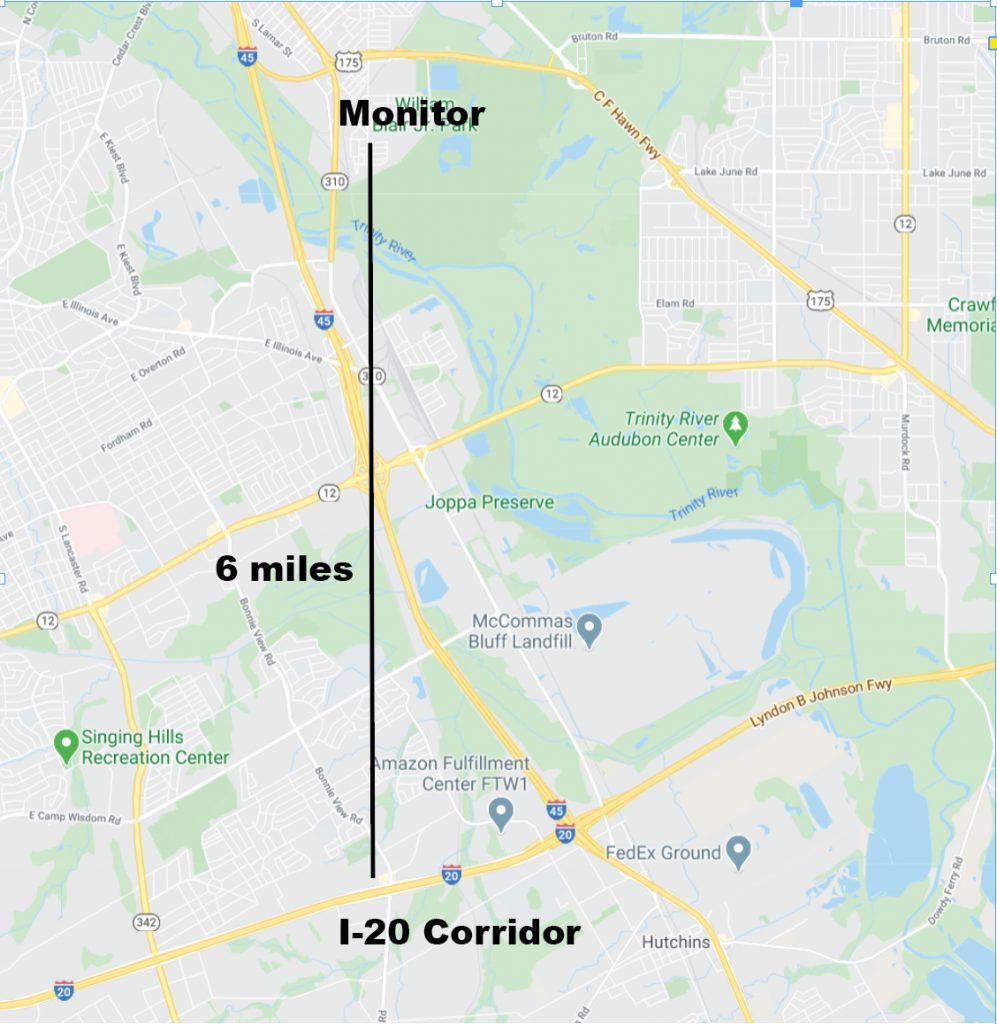
Since there’s no heavy industry in Bonton like there is in Joppa, even if the new monitor records extremely high levels of PM pollution, we’ll have no idea what’s causing it. No one to blame. That may be by design.
Dallas OEQS has a history of not wanting the job of telling people they’re breathing crap. Staff refused residents’ pleas to bring the City’s portable monitors to Joppa in the middle of the Dwaine Caraway batch plant fight three years ago. It’s refused to deploy monitors at Shingle Mountain. Staff walked out of participating in the on-going UTD air monitor network deploying over 100 sensors throughout DFW. Staff has refused to use a dozen brand new air monitors it’s locked up in storage after a failed project with DISD. While other cities race to establish dense 21st century air monitoring networks, Dallas defaults to a single 1990’s-era PM monitor and calls it quits.
This lack of imagination and initiative is the result of having a lawyer, James McQuire, in charge of OEQS instead of a toxicologist. The lawyer’s goal is to meet minimum regulatory standards. The toxicologist’s is to improve public health.
The one overarching air quality goal of this OEQS and the new Climate Plan is to keep Dallas from violating the Clean Air Act. It’s a low bar considering all of the legal “standards for PM show there is no safe level of exposure to the pollutant and people are dying from being poisoned by PM in areas that meet those standards.
One way to meet those standards and insure your goal is by not being too curious about health impacts. You limit the amount of testing and where you test – another page out of the Trump playbook. You don’t go looking to put monitors where air pollution is high, like Joppa or next to a freeway. That’s thinking like a toxicologist and it could put you in violation of the federal standard pretty fast. Instead, you put the monitor where you know the pollution isn’t – like Bonton, 3 miles away from Joppa and 6 miles away from I-20.
So this monitor gives staff the best of all its possible worlds – they get to claim they got a new monitor for Southern Dallas that doesn’t really accomplish much, without it actually being a City of Dallas monitor. If it ever does reveal terrible numbers one day, it will be the state downplaying the results, not City staff. (Lawyer’s) mission accomplished.
And because its a state monitor, don’t expect it to be easy to find online, or give you any real time data. There was no hint by staff of how the data from this monitor would be accessible to the public. Also no timeline for its installation and no air modeling offered to back-up the claim it could capture PM pollution from Joppa sources. All you have is staff’s word. A staff that doesn’t want to find air pollution problems.
What was as discouraging as staff not offering any of these important details was that not one Council Member on the Environmental Committee knew enough about air quality to ask about them as well. Nobody on the City Council knows enough about this topic to make an informed decision or even ask the right questions. And nobody on staff is going to quit misleading them. Meanwhile Environmental Health in Southern Dallas – and everywhere else – is held hostage.
Despite it being a heavily debated topic during last Wednesday’s council meeting there wasn’t even a single question about the City performing air monitoring at the site of the controversial Asthma Cave Soccer Fields under I-345 or the OEQS staff’s opinion about the safety of the concept. It’s just as well. They probably would have endorsed it as a great recreational opportunity for kids.
Video recording of the Monday, June 1st Dallas City Council’s Environmental Quality and Sustainability Committee is available to watch here; the Dallas monitoring presentation begins at 38:20: https://dallastx.swagit.com/play/06012020-522
Urge the Dallas Council To Restore the Environmental Health Commission on May 27th
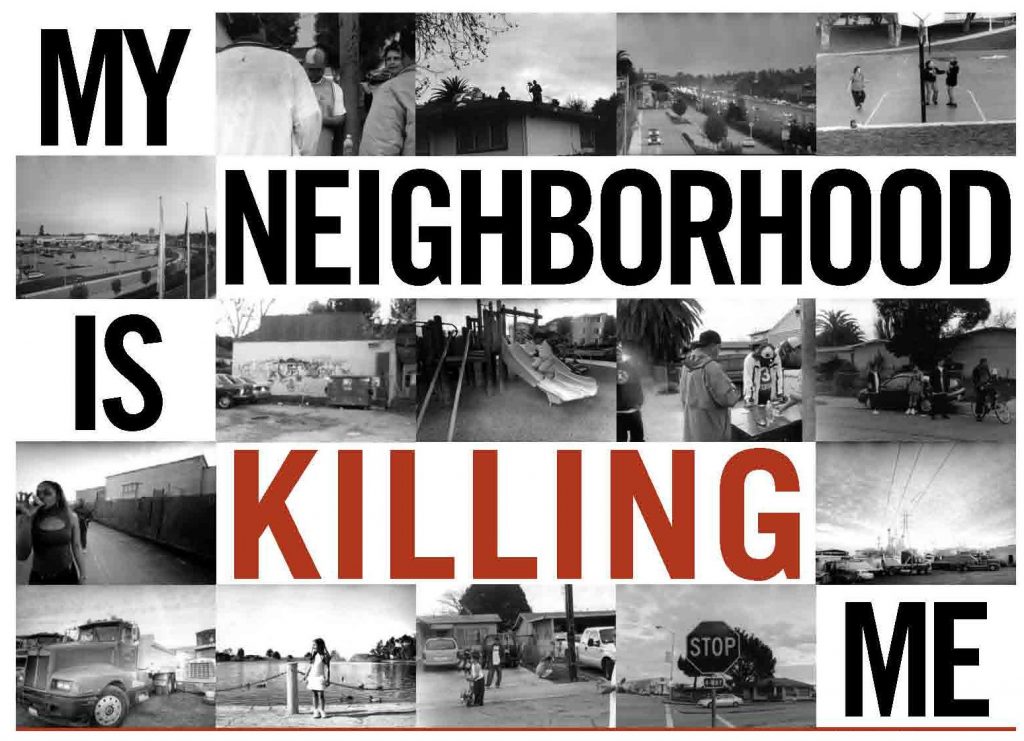
CLICK HERE TO SEND AN EMAIL RIGHT NOW. YOU CAN ADD YOUR OWN COMMENTS
For over a year Southern Sector Rising has been lobbying the City Council for the restoration of the Dallas Environmental Health Commission. With the adoption of the City’s Climate Plan, the Council has a chance to do that next Wednesday , May 27th. But they must hear from you.
Opposition is coming from management in the Office of Environmental Quality and Sustainability who don’t want the word “health” used for this new body. Why? Because this is the same city staff who doesn’t want to responsibility of telling citizens they have bad air or are living too close to industry. Houston has a staff toxicologist advising City Hall. Dallas has a lawyer.
This is why residents must have the Dallas Environmental Health Commission. It serves as a citizen-friendly forum for putting environmental health issues on the official City Hall radar and generates important new public policy proposals. Every Council Member would appoint a member and various experts would serve as advisors. It would instantly elevate the status of Environmental Health at Dallas City Hall.
You can help make this happen by sending a quick “ClickNSend” email to Mayor Johnson and the City Council urging them to vote for a new Dallas Environmental Health Commission. You can add your own comments as well. It takes all of 30 to 60 seconds, and it could mean the difference between Dallas and the next Shingle Mountain.
HERE’S THE LINK TO SEND YOUR EMAIL TO THE MAYOR AND COUNCIL https://www.downwindersatrisk.org/featured-citizen-action/
Thank you.
A BIG THANK YOU
You Contributed Over $21,000 for Our
COVID-Connected Program Work Last Week

In our first ever attempt to conduct a week-long fundraising campaign, much less during an unprecedented pandemic, we had unprecedented success. Over seven days our supporters contributed a total of $21,600 to Dowwinders at Risk. That’s the most we’ve ever raised during one of our fundraising drives.
Besides raising needed funding for our work, we also received national exposure through the Peace Development Fund’s Grassroots Fundraising Week that featured us and 12 other grassroots groups doing social justice work around the country during the COVID crisis.
These new funds will be used to support our zoning equity work surrounding he upcoming “forwardDallas! land use planning process, the new regional air monitoring network we’re building, assistance to grassroots groups such as Southern Sector Rising, and continued original reporting of local environmental news.
We can’t tell you how much we appreciate the contributions, especially in light of the circumstances. We value your support and pledge to squeeze every bit of change out of every dollar you send us. Thank you.

DIRECTOR

CHAIR
Our Environmental Reporting is This Week’s Final Reason to Give


It’s Friday. That means it’s the last day of our
COVID-connected fundraising campaign
Thank you to everyone who’d contributed and helped us spread the word during this week’s fundraising onslaught. It’s been a tremendous success. We’ll be able to announce the final numbers next week, but we’re very grateful.
This is the first time we’ve combined a Giving Day with four more days of pitching ourselves as a good investment. We tried to educate while we begged but we know you’ve seen a lot of emails from us this week. Together, those emails do a good job of describing our current agenda.
If you haven’t already contributed, we’re using today to give you one more reason to give, but it’s not officially part of our program work – it’s a consequence of it.
It’s not too late to help us help more people. All money stays in DFW.
If you’ve read even one of the other emails this week you know we’ve got ambitious plans. Support them if you can. Thanks.
Thanks,


________________________________________
COVID Connects:
Grassroots Reporting
to
Environmental Health Awareness

What is It?
When Downwinders began, there were three major daily newspapers in DFW and they all had environmental reporters assigned to cover local stories. All three “major” TV network affiliates also had environmental reporters. Now, there’s not a single commercial media outlet in DFW that employs a full-time, dedicated environmental reporter.
That’s why the original research and reporting we do is so important.
Our website, Facebook, and Twitter pages offer the most comprehensive list of studies and news articles on air pollution and the contemporary environmental movement of any entity in DFW. Whether you want to see the latest research or read about green politics, we offer news that nobody else will bring you – every single day.
But we also make our own news.
We do our own research, submit our own Open Records Act requests, and make our own calls to our “sources.” We tell the stories behind the press releases that no other outlet does.
That’s how we brought you the story of the mysterious North Texas catastrophic air pollution event that sent monitors numbers soaring but had no official explanation. That’s how we reconstructed the Sunshine junk yard fire in West Dallas to prove their was no air monitoring by the Dallas Fire Department despite official reassurances to the contrary.
It’s how you know Dallas City Hall is sitting on 12 brand new air monitors it doesn’t want to use in its own neighborhoods. It’s why you know an Asphalt batch plant in urban Joppa is operating with a permit and air modeling based in rural West Texas. It’s how we compile our annual smog reports.
And if you wanted to follow the Dallas Climate Planning process, we offered an unprecedented six articles detailing its background and politics over a year. We devoted more research, words, and space to giving you a unvarnished look at it than the Dallas Morning News, The Dallas Observer and D Magazine combined.
Why Do It?
We’ve become our own news organization because we’ve had to. Otherwise, you’d never know about what was really going on.The sometime “environmental reporter” for the Morning News is also the weather reporter, and also a general assignments reporter. He has no experience covering environmental issues, and more often than not ends up copying and pasting news releases.
Other mainstream media outlets are equally uninterested or unable to have someone with experience report on local environmental news.
And polluters and governments love it when nobody is asking pesky questions or challenging the official statements.
That leaves it up to the people and groups in the field doing the work to report on it as well.
What’s the COVID
Connection?
To make the best decisions about environmental health, you need the best information. You need to know what solutions have worked and which ones haven’t. You need to know the research that proves or disproves connections between pollution and a specific illness. You need to separate the BS claims from the reality on the ground.If we all just rely on official sources of information about air pollution and environmental justice, we’ll never see the real stories. Truth is the citizen’s friend, whether fighting a permit or a pandemic.
STATUS?
We publish fresh news on our Facebook page and Twitter account every day. We publish deeper dives on our website and in these email alerts. We keep you informed of the latest developments on the local environmental movement in a way no other group or media outlet does.
Our reporting isn’t program work that we apply for grants to fund. It happens as a result of us pursuing the truth as we perform our program work. It’s the only way we have of explaining to you how hard change is sometimes, or what it really means when we win.
Don’t Miss the Big Searchlight Finale Tonight; Stand with Southern Dallas
Mayor Johnson is still a No-Show
At Shingle Mountain today
So we’re leaving the lights on to help him find us tonight
The company we’re renting these searchlights from promised a 25-mile view radius.
Help us learn if we got our money’s worth. Let us know if you can see it from where you are tonight and if you can,
take a picture and post it on
our FaceBook Event feed
Tonight’s light show is the big finale to our day-long action to help Dallas Mayor Eric Johnson find his way to Shingle Mountain and Environmental Equity.






Besides looking for our searchlights tonight, you can also…
1. Adopt a sign to help
Mayor Johnson Find His Way
We’re putting up 200 of these signs all over town. Want one near you? All you have to do is contribute what you can at our secure pay portal here, and make a request for a sign at the bottom of the form.
You can track where signs are popping up on this live Google map.
 Find one, take a sign selfie and send it in.
Find one, take a sign selfie and send it in.
Thanks.
2. Send a Letter To Mayor Johnson To Help Him find His Way to Shingle Mountain and Environmental Equity
Our ClickNSend letter app takes all of 30  seconds, allows you to add your own message, and tells Mayor Johnson and Dallas City Hall you support Environmental Justice. Thanks
seconds, allows you to add your own message, and tells Mayor Johnson and Dallas City Hall you support Environmental Justice. Thanks
3. Help us pay for these darn signs and searchlights.
We wanted to do justice to both the issues in Southern Dallas and the 50th Anniversary of Earth Day. If you think we succeeded please consider a contribution through our secure pay portal to offset the costs of a more memorable Earth Day 2020. Thanks.



